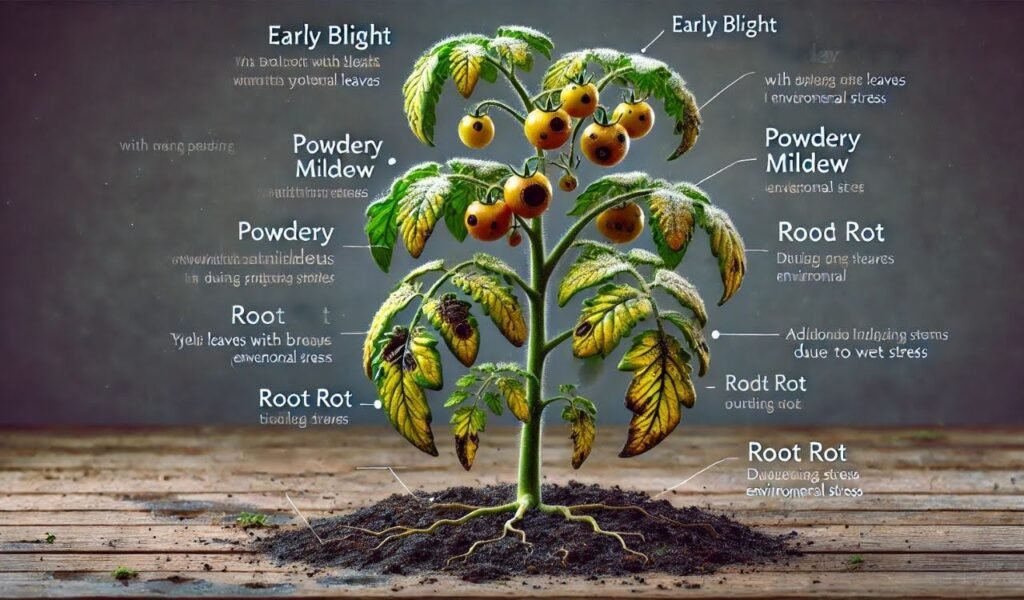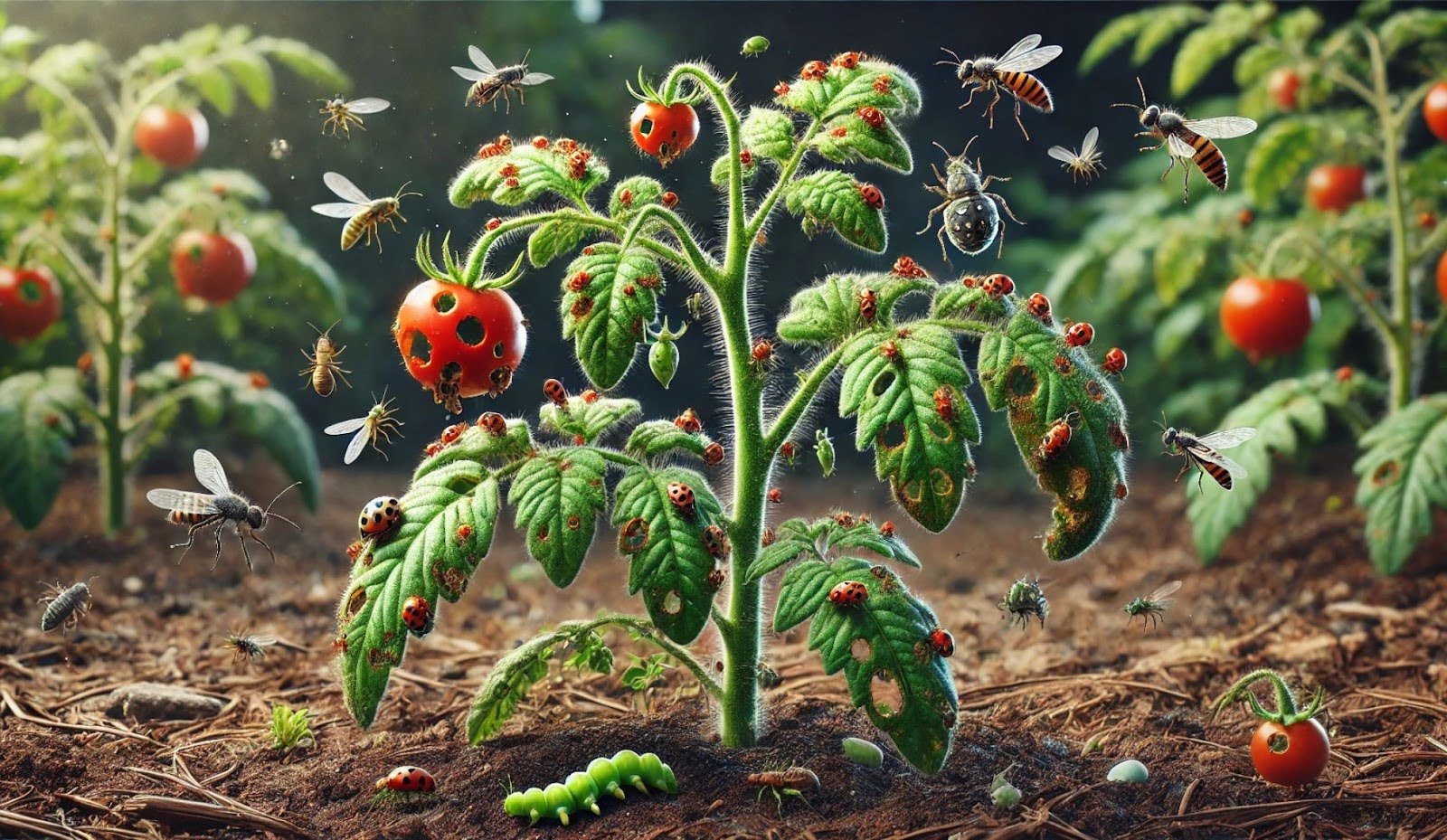What is Eating My Tomato Plants? A Complete Guide for Backyard Gardeners
What is eating my tomato plants? If you’ve spotted holes in the leaves, yellowing, or strange bugs lurking around, you’re not alone. Pests and diseases love tomato plants as much as we do, and they can wreak havoc fast. From tiny aphids to stubborn fungi, there are plenty of culprits ready to ruin your harvest. Don’t panic—this guide will help you identify the problem and fix it before it’s too late. Let’s dive in and save your tomatoes!
What is eating my tomato plants?
Tomato plants attract a variety of pests that can chew through leaves, stems, and fruit, leaving behind damage and reduced yields. Identifying the culprits is crucial to protecting your crop and ensuring a healthy harvest.
Common Pests That Damage Tomato Plants

To know about What is eating my tomato plants?, we first have to understand the basics of the common pests that damage tomato plants. These pests can attack different parts of the plant, causing wilting, holes in leaves, and damaged fruit, ultimately affecting your harvest.
1. Aphids on Tomato Plants
Aphids are small, soft-bodied insects that can quickly infest your tomato plants. These tiny pests can be green, black, white, or even pink.
Signs of Infestation:
Clusters of tiny bugs on the undersides of leaves and stems. Sticky residue (honeydew) on leaves, which may attract sooty mold. Yellowing and curling of leaves.
How to Deal With Aphids:
Natural Predators: Introduce ladybugs or lacewings to your garden. These insects feast on aphids and help keep their population in check.
Insecticidal Soap: Spray the affected areas with a solution of water and insecticidal soap. Neem oil is another effective option.
Manual Removal: Use a strong jet of water to dislodge aphids from your plants.
2. Stink Bugs on Tomato Plants
Stink bugs are shield-shaped insects that puncture tomatoes to feed on their juices, leaving behind unsightly spots on the fruit.
Signs of Infestation:
Small, discolored spots on the surface of tomatoes. Presence of adult stink bugs or their egg clusters on leaves.
How to Manage Stink Bugs:
Handpicking: Wear gloves and pick off stink bugs from your plants. Dispose of them in soapy water.
Row Covers: Use row covers to protect young plants during the early stages of growth.
Attract Beneficial Predators: Birds and spiders naturally prey on stink bugs.
3. Tiny White Bugs on Tomato Plants
If you notice tiny white bugs flying up when you disturb your plants, you’re likely dealing with whiteflies. These pests can cause stunted growth and yellowing leaves.
Signs of Infestation:
Small white bugs on the undersides of leaves. Yellowing or curling leaves. Sticky honeydew on the plant.
How to Get Rid of Whiteflies:
Sticky Traps: Hang yellow sticky traps near your tomato plants to catch whiteflies.
Neem Oil Spray: Apply neem oil to repel and kill whiteflies.
Introduce Predators: Ladybugs and green lacewings are natural predators of whiteflies.
4. Small Black Winged Insects on Tomato Plants
Small black flying insects like fungus gnats or thrips can also damage your tomato plants.
Signs of Infestation:
Presence of tiny, dark bugs around the plants. Thrips may cause leaf curling or distorted growth. Fungus gnats are often found in overly damp soil.
How to Address Black Winged Insects:
Improve Soil Drainage: Ensure your soil is well-draining to deter fungus gnats.
Sticky Traps: Use traps to capture flying pests.
Neem Oil Spray: Effective for both thrips and fungus gnats.
5. Red Bugs on Tomato Plants
Red bugs on your tomato plants could be spider mites or clover mites. These pests are especially troublesome in hot, dry conditions.
Signs of Infestation:
Red or bronze stippling on leaves. Fine webbing (spider mites) on the plant.
How to Treat Red Bugs:
Increase Humidity: Mites thrive in dry conditions, so mist plants or introduce humidity.
Spray Soap Solution: Use a mixture of water and mild soap to kill mites.
Encourage Beneficial Insects: Predatory mites and ladybugs can help control infestations.
6. Green Caterpillar on Tomato Plants
Tomato hornworms are large green caterpillars that can quickly defoliate your plants if left unchecked.
Signs of Infestation:
Large holes in leaves. Presence of frass (droppings) around the plant. Green caterpillars on stems and leaves.
How to Handle Tomato Hornworms:
Handpicking: Remove caterpillars manually and dispose of them.
Encourage Natural Predators: Birds and parasitic wasps are effective in controlling hornworms.
Fungal Diseases and Environmental Issues

1. Early blight
Occurs on the foliage, stem, and fruit of tomato as well as potato.
Signs:
In tomato, the disease first appears as small brown to black lesions with yellow haloes on older foliage. Entire leaves may become chlorotic (yellow) where many lesions coalesce.
Solutions:
Remove infected leaves: Remove leaves with spots and burn or bury them.
Apply fungicide: Use a fungicide to kill fungal spores. You can use a synthetic or organic fungicide.
Water at the base: Water the plants at the base to avoid wetting the leaves.
Use resistant varieties: Plant varieties that are resistant to early blight, such as Juliet F1, Tommy Toe, or Cabernet F1.
Rotate crops: Don’t plant the same crops in the same area each season.
Destroy plant debris: At the end of the season, remove all plant debris and burn or bury it.
2. Black or Dark Spots on Tomato Plant Leaves
Black or dark spots on leaves often indicate fungal diseases such as early blight, Septoria leaf spot, or bacterial spot.
Signs:
Circular or irregular black spots, sometimes surrounded by a yellow halo. Leaves may yellow and drop prematurely.
Solutions:
Prune Affected Leaves: Remove and destroy infected leaves to prevent the spread.
Fungicide Applications: Use copper-based fungicides to control fungal infections.
Practice Crop Rotation: Avoid planting tomatoes in the same spot each year.
3. Powdery Mildew on Tomato Plants
Powdery mildew appears as a white, powdery coating on leaves and stems.
How to Manage Powdery Mildew:
Improve Air Circulation: Space plants properly and prune dense foliage.
Fungicidal Spray: Use sulfur-based fungicides to treat the affected areas.
4. Tomato Plant Leaves Turning Brown
Browning of leaves can occur due to sunscald, nutrient deficiencies, or diseases like early blight.
How to Address:
Provide shade during extreme heat. Test soil for nutrient imbalances and fertilize as needed.
5. Curling Leaves on Tomato Plants
Leaf curling is often a response to stress from heat, pests, or watering issues.
Causes and Solutions:
Heat Stress: Provide shade during hot days.
Pest Infestations: Inspect for pests like aphids or thrips and treat accordingly.
Watering Imbalance: Ensure consistent watering without over-saturating the soil.
Prevention Tips for Healthy Tomato Plants
Preventing issues is always better than treating them. Here are some actionable tips:
- Maintain Proper Spacing: Ensure adequate airflow to reduce the risk of fungal infections.
- Crop Rotation: Avoid planting tomatoes in the same location for consecutive years.
- Regular Inspection: Check your plants weekly for pests or signs of disease.
- Use Companion Plants: Plant marigolds or basil near your tomatoes to repel pests naturally.
- Avoid Overwatering: Allow soil to dry between watering to prevent root rot and fungal growth.
- Keep Weeds in Check: Weeds can harbor pests and compete for nutrients.
- Mulching: Apply mulch to retain soil moisture and deter weeds.
FAQ
What are common pests that attack tomato plants?
Aphids, stink bugs, whiteflies, fungus gnats, spider mites, and tomato hornworms are common pests.
How can I get rid of aphids on tomato plants?
Use natural predators like ladybugs, insecticidal soap, or a strong water spray.
What causes small discolored spots on tomatoes?
Stink bugs feed on tomato juices, leaving behind discolored spots.
How do I manage stink bugs?
Handpick them, use row covers, and attract beneficial predators like birds.
What are the signs of whitefly infestation?
Tiny white bugs on leaves, yellowing leaves, and sticky residue.
How can I prevent whiteflies?
Use yellow sticky traps, apply neem oil, or introduce predators like lacewings.
What causes large holes in tomato plant leaves?
Tomato hornworms, large green caterpillars, cause these holes.
How do I remove tomato hornworms?
Handpick them or encourage birds and parasitic wasps to control their population.
What are common fungal diseases in tomato plants?
Early blight, Septoria leaf spot, and powdery mildew are common fungal diseases.
How do I treat early blight?
Remove infected leaves, use fungicides, water at the base, and rotate crops.
Conclusion
Growing tomato plants is a rewarding experience, but it comes with its challenges. By identifying and addressing common issues like pests, fungal infections, and environmental stress, you can keep your tomato plants healthy and productive. Regular monitoring, proper care, and preventive measures are key to ensuring a bountiful harvest. Armed with the knowledge from this guide, you’re now ready to tackle whatever might be eating your tomato plants and enjoy the fruits of your labor. Happy gardening!







